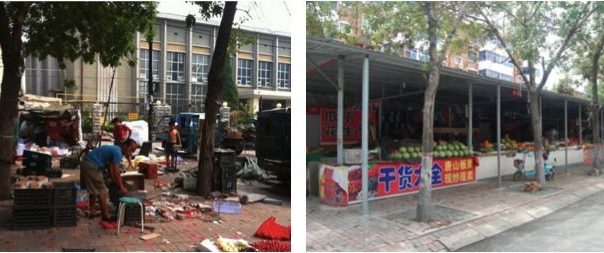As the world is fighting against climate change, many Chinese cities are now trying to transition towards a low-carbon development pathway. Beijing, the capital city of China, promised to peak its carbon emissions by 2020, an ambitious target that inspires all of its citizens. And the city has actually made progress on this.
However, we have heard voices from different angles on this progress. A friend told me that since 2014, many retailers in downtown Beijing have closed down their businesses and moved out of urban districts. These retailers consist mostly of migrants, who have typically worked in community and small commodity markets, barbershops, restaurants, beauty salons, public baths, and in other services for years. Their departure is a great loss to Beijing, and brings inconvenience to urban residents in Beijing’s downtown. As China’s capital city, Beijing is welcoming friends from all over the world with the objective of building a World City. “Welcome to Beijing”, the theme song of the 2008 Beijing Olympic Games, intends to convey the open-mindedness and hospitality of the capital city. But now, why are these migrants leaving Beijing?
1. Decentralization to tackle urban problems
Like other megacities, Beijing has experienced common urban problems such as environmental degradation, traffic congestion, resource deficiency, and soaring housing prices, etc., in the process of its development. The Chinese leadership decided to follow a low-carbon pathway, and to solve the capital’s urban problems at a regional level, as a means of addressing these issues. In recent years, policies of coordinated and integrated development in Beijing, and its two surrounding Provinces, Tianjin and Hebei, have been enacted. The objectives of these policies are to maintain the function of the capital city, to move the non-capital functions to the surrounding areas, and to balance the development of Beijing, Tianjin, and Hebei. The main approach to achieving these goals has been to decentralize the excessive population and the so-called “inappropriate and low-end industries” from urban Beijing, moving them to the surrounding regions. According to the “Coordinated Development Plan of Beijing, Tianjin and Hebei” issued by the central government in 2015, Beijing’s total population shouldn’t exceed a 23 million person cap, and by 2020, it is planned to decrease by 15 percent compared to its 2014 level (in 2014, the population reached 21.51 million, and it shows an increasing trend). In this context, Beijing is trying to relocate population and industries out of the urban districts.
The retailers I mentioned above and the “low-end industries” in which they are engaged are regarded as the first people and activities that ought to be moved out of the urban centers. According to statistics, during the first half of 2016, the population of the six urban districts of Beijing decreased by 95,000, the first decrease since the founding of PRC in 1949. The decentralization policy is starting to work. However, are we not losing something with the exodus of these migrants and their businesses? We are. We are losing convenient public services and amenities close to us, and we are losing vitality and diversity of the city.
2. Negative effects of the decentralization of migrants
The loss of migrant populations brings inconvenience to urbanites and influences the livelihoods of the migrants who leave. Because most of the decentralized migrants work in service sectors, their departure causes a serious lack of basic services essential to the locals’ lives. In addition, migrants who leave lose their jobs, and their family members are forced to move from their familiar surroundings (e.g., the kids need to go to other schools).
In the community where I live in northwest Beijing, there used to be a daily necessity market that had operated for over 20 years. It occupied an area of 19,000 m2, and had more than 900 shops. This market served the communities within a radius of 5 km, and was beloved by local residents. Regretfully, the market was demolished in 2014. The government said that the marked caused a large flux of people and traffic jams. I am not sure whether tearing down the market was the only solution to tackling congestion in this case, but I am quite sure that our lives became more difficult without the market, and thousands of migrants who had been working in retail needed to find new jobs. According to government officials, by the end of 2014, 43 markets like this had been demolished in Haidian District alone, one of the six urban districts in Beijing.

Loss of migrant communities will also cause an imbalance of urban space and a loss of vitality of the city. As migrants and “low-end” industries move out of the town, local residents turn to amenities that are usually more expensive and located farther away in order to satisfy their daily needs. Living costs subsequently increase, which may result in the movement of elders and the low and medium-income groups, as well. Eventually, rich people will be gathered in the urban areas, while the poor live on the periphery. This will cause social stratification, and an unbalanced population structure in space, which poses a potential threat to social stability. Moreover, as the “low-end” industries move out of town, the industrial structure left downtown tends to be unitary; it loses diversity, and, inevitably, the vitality of urban areas is reduced.
3. The way towards an inclusive Beijing
Beijing is determined to build a World City, which should be inclusive. We can’t drive all the migrants and so-called “low-end” industries out of urban districts, as these people and their work are greatly needed by the urbanites. E. Saarinen proposed the Theory of Organic Decentralization in 1940s, and it was adopted widely all over the world. At the present development stage of Chinese megacities, such as Beijing, I think the main point in implementing this theory is to make our decentralization better coordinated and better planned.
First of all, experts, the general public (including representatives of the migrant population), and officials from different government authorities should meet regularly before making a coordinated plan or final decision on such issues. In Chinese cities, different plans are compiled and supervised by different government institutions, such as land use plans (by the land and resources bureau), transportation plans (by the transportation commission), urban plans (by the urban planning bureau), social economic plan (by the development and reform commission), etc. The problem is, authorities and experts involved in making different plans usually do not communicate effectively with each other. This has caused inconsistencies to arise between various plans, so that the implementation of those plans did not produce optimal results. Like the commodity market under discussion, if transport planning and land use planning had gone hand-in-hand from the beginning, starting 20 years ago, traffic congestion might not occur today. Likewise, if today, different stakeholders can meet together in the decision-making process of decentralization, it will result in a more scientific and coordinated plan for the future.
Secondly, there might be other alternatives to solving urban problems that are perceived to be caused by high density population and “inappropriate” industries, rather than decentralizing the migrants all at once. For instance, in order to mitigate the perceived problems caused by an excessive migrant population and the industries they engage in, the government could strengthen the supervision of retailers and industries, could provide and encourage more transit services, could set up one-way streets, could develop and utilize underground space, and could establish low emission zones.
Take the approach of strengthening government supervision, for example; Cangzhou city makes a good case study. Located 200 km southeast of Beijing, and with a population of 7.44 million, Cangzhou faces urban problems like other Chinese cities, one of which is how to deal with street vendors. Typically, street vendors are migrants coming into urban areas to earn a living. The goods they sell and services they provide are needed by citizens, but street vendors are also blamed for causing dirty, disorderly, and bad environments. By building unified market stalls for street vendors, Cangzhou government can tighten supervision on the migrants. At the same time, this policy actually keeps the migrants’ livelihoods intact, and improves their surrounding environments.


Thirdly, the government should synchronize decentralization and resettlement. If the government decides to decentralize the migrants, it should make an all-out effort to help those shifting populations by providing new employment opportunities, services, and facilities in the outskirts of cities and new towns to which the migrants are moving. Hong Kong sets a good example of “planned” decentralization. In order to solve the housing problem of the growing population in urban areas, the government built nine new towns from the 1970s to the 1990s. Before the newcomers moved in, the government introduced industries, public services, and transport facilities into the new towns. This way, people could find new jobs and were more eager to move.
Beijing needs its migrant population; its contribution to the city is critical towards its development as a World City. The government needs to follow coordinated and planned decentralization policies to achieve its social, economic, and environmental objectives. As an ordinary citizen of Beijing, I hope that the rhythm of “welcome to Beijing” rings out loudly under the clear sky.
Pengfei XIE
Beijing











Add a Comment
Join our conversation